Do you want to taste the fresh, versatile flavor of courgettes (or zucchini) from your garden?
These summer squashes can be very rewarding to grow. They offer you a constant source of delicious fruits during the season.
But it might be confusing at first. We will share with you the best ways to grow healthy courgette plants. You’ll soon love the taste of your homegrown crops.
What Are Courgettes and Why Grow Them?
Courgettes, also known as zucchini, are a top choice for home gardens. They are easy to grow and give plenty of fruit. With just one plant, you can pick fresh courgettes from summer to early fall.
Growing courgettes has many benefits. They offer a lot of options for dishes and salads. Plus, you can eat the flowers. By growing your own, you get tastier vegetables than those from a store.
The popularity of courgettes makes sense. They are easy and quick to grow. In just six weeks, you can have fresh courgettes. With a few plants, your family can enjoy plenty of veggies in the summer.
| Courgette Benefit | Description |
|---|---|
| Flavor | Homegrown courgettes taste better and are less bitter than store-bought ones. |
| Yield | One plant can give you lots of fruit each week once it starts growing in midsummer. |
| Versatility | They are great for many summer meals and are even used in salads. The flowers are edible, too. |
Courgettes’ versatility and abundant harvests make them a favorite. By growing your own, you’ll appreciate the joy of fresh, tasty vegetables. You’ll also discover new ways to use this great summer vegetable.
Choosing the Right Courgette Variety
There are many courgette (zucchini) types, making picking the right one fun! You’ll find them in all sizes, shapes, and colors. This variety lets you match them to your garden and tastes.
Key Considerations
When picking a courgette kind, consider several points:
- Plant Size: Some are small and bushy, others need more space. Think about your garden size.
- Fruit Shape and Color: You can find them in different shapes and colors. Pick what looks best to you.
- Disease Resistance: For wet summers, choose kinds that fight disease.
- Ornamental Appeal: Some varieties look pretty and are tasty too. They’re great for looks and food.
For top picks, choose those with the RHS Award of Garden Merit. These are known to do well in many places.
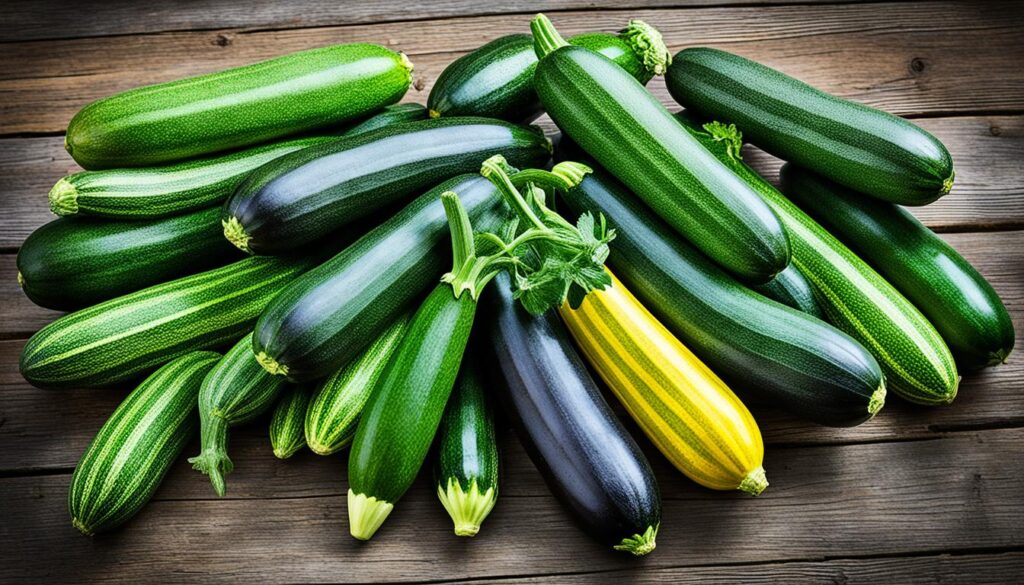
When there are so many choices, think about your space and what you like. This way, you’ll pick the perfect courgette for your garden.
How to grow courgettes: Sowing and Planting
Courgettes are a great choice for your vegetable garden. They give you lots of veggies with little work. To grow them right, you need to know the best times and ways to plant. This guide will show you whether to start seeds indoors or plant them outside.
Sowing Indoors
Courgette seeds should be started indoors if you want an early crop or live where it’s cold. Plant each seed on its side, 1/2 inch deep, in small pots with moist compost. Keep the pots in a warm place, like on a sunny windowsill, at 18-21°C (64-70°F). They should sprout in about a week or two.
Sowing Outdoors
To plant your courgettes outside, wait until late May or early June. By then, the soil should be warm. Mix in compost or manure to make the soil better for the seeds. Plant two or three seeds, 1 inch deep, and cover them with a cloche or fleece. This keeps away pests. Outdoor planting is a bit riskier than indoors but can work well.
After planting, always keep the soil moist until the seeds begin to grow. When plants start to show, take off the covers and keep the strongest ones. With the right care, your courgette plants will do well and give you many vegetables.
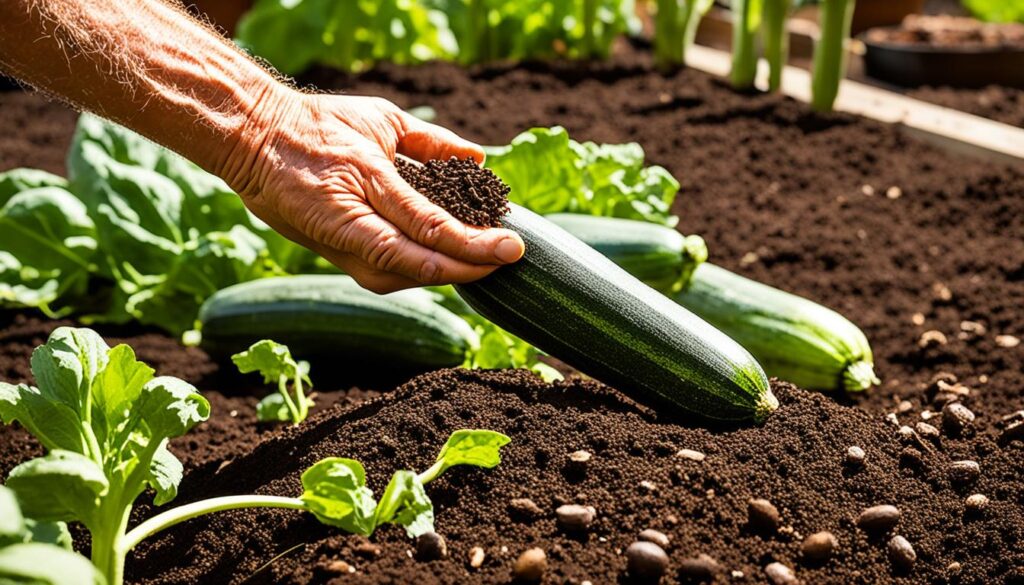
Planting and Spacing
Transplanting courgette seedlings requires careful planting and spacing. To get a good harvest, courgette plants need the right amount of space. The distance between plants can be 1 to 3 feet, depending on the type you grow.
If you have a smaller type, plant them closer, about 1.5 to 2 feet apart. For the bigger types that vine out, give them more space, around 2 to 3 feet apart. In pots, space them at least 1 to 2 feet apart.
For row planting, keep 1.5 to 3 feet between plants. Also, make sure there’s 3 feet of space between each row. In raised beds, plant them with 1.5 to 2 feet of space. If you’re growing them up, not out, they can be closer, like 1 to 1.5 feet apart.
Sow courgette seeds outside and space them 3 to 4 inches apart. When they start growing, thin them. Leave only the strongest, spacing them 1 to 3 feet apart, depending on type.
| Planting Scenario | Recommended Spacing |
|---|---|
| Smaller, compact courgette varieties | 1.5 to 2 feet apart |
| Larger, vining courgette varieties | 2 to 3 feet apart |
| Courgettes in containers | At least 1 to 2 feet apart |
| Courgettes planted in rows | 1.5 to 3 feet between plants, 3 feet between rows |
| Courgettes in raised beds | 1.5 to 2 feet between plants |
| Vertically grown courgettes | 1 to 1.5 feet apart |
| Courgette seeds sown directly outdoors | 3 to 4 inches apart, then thinned to 1 to 3 feet |
Proper transplanting courgette seedlings, site preparation, and taking care of the growing conditions are key. This ensures your courgettes not only survive but thrive, giving you a great harvest.
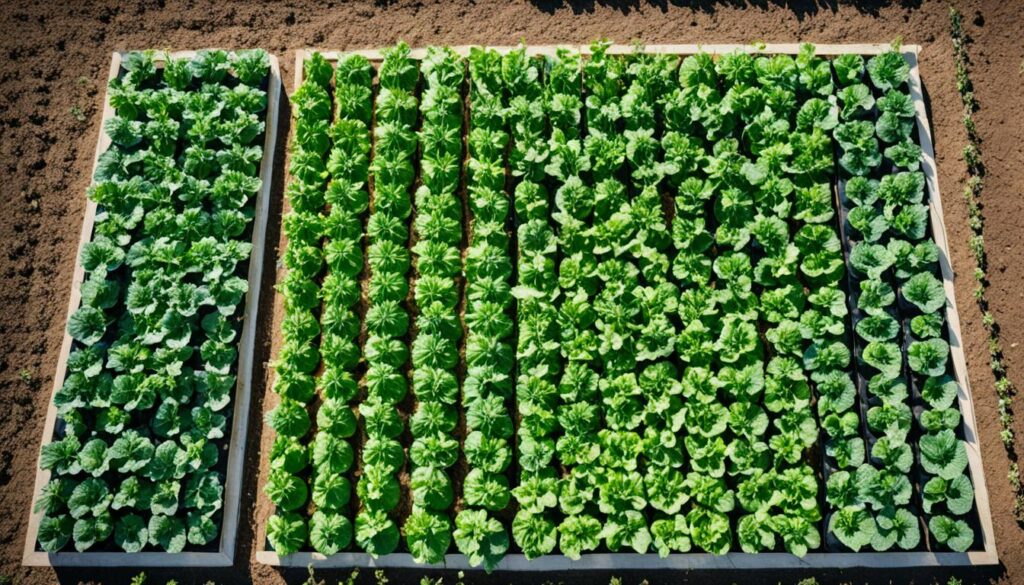
Ongoing Care and Maintenance
To keep your courgette plants healthy, you need to give them regular care. This means they need proper watering and feeding. We’ll explore the key steps to take for a good harvest.
Watering
Courgette plants like water, and they need it often to grow well. It’s best to keep the soil moist all the time, especially if they’re in pots. Avoid getting the leaves wet to prevent a disease called powdery mildew.
It’s best to water them in the morning. This gives the leaves time to dry. If they are in pots, place another pot nearby and water in there. This helps the water go straight to the roots.
Feeding
To get lots of healthy fruits, feed your courgette plants often. Use a fertilizer that’s rich in potassium every 10-14 days after the first fruits show up. This feed will give them the energy they need to make fruit.
Also, you might want to put some mulch around the plants. Mulch keeps the soil moist and stops weeds from growing. This way, your plants get more of the nutrients they need.
| Courgette Care Essentials | Recommended Practices |
|---|---|
| Watering |
|
| Feeding |
|
By caring for your courgette plants with the right watering and feeding, they will grow well. You’ll enjoy a great harvest all season long.
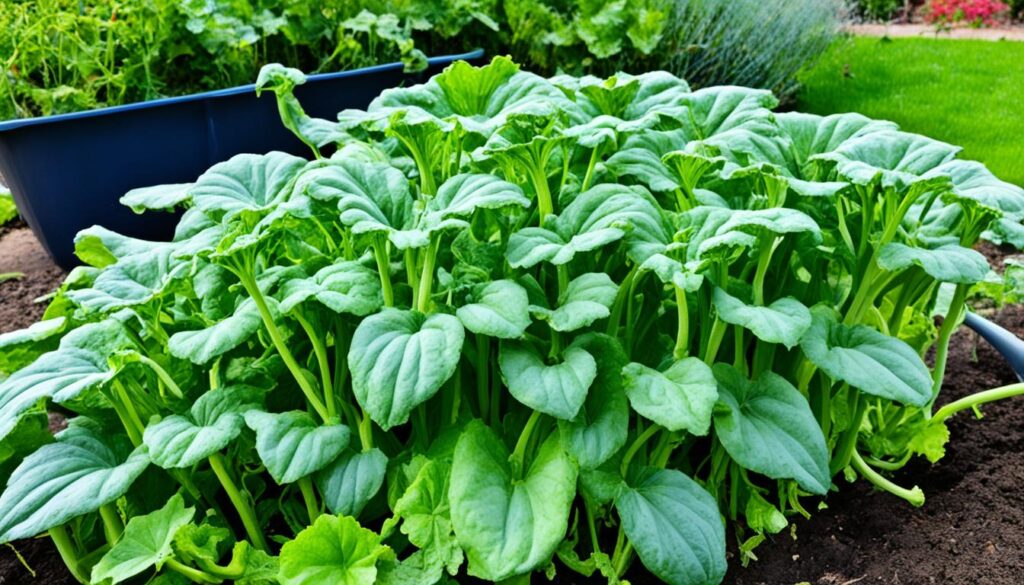
Pruning and Training
To keep your courgette plants healthy and productive, you need to prune and train them right. With a few steps explained here, your courgettes will do great. Plus, you’ll avoid problems like powdery mildew and boost air flow around your plants.
Get rid of old or powdery mildew covered leaves often. This makes the fruits get more sunlight, making them easier to pick. It also improves air circulation to fight off fungal diseases.
If your courgettes are in a pot, they might fall over without help. You can put a 6-foot stake nearby and tie the plant to it as it grows. This keeps the plant up, focusing its energy on making fruit.
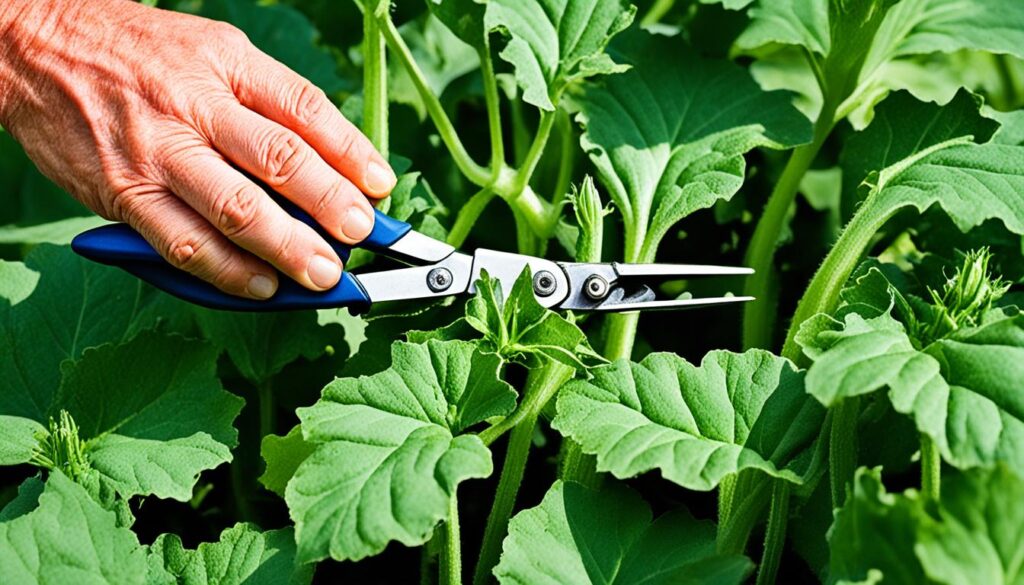
Keeping your courgette plants trimmed and standing tall has many benefits:
- Reduces the chance of powdery mildew and other fungi
- Makes it easier to pick the fruits
- Uses your garden space better, letting you grow more crops
- Helps pollination by making flowers easier for pollinators to reach
Adding these pruning and training tips to your gardening will lead to lots of healthy courgettes to enjoy.
Harvesting Your Courgettes
Getting your courgettes at the right time is so important. You want them to taste great and be the right texture. The best size to pick them is when they’re around 10-12.5cm. This is when they’re small and soft. Picking them regularly helps your plant to keep growing more.
Besides the courgette fruit, you can also pick and eat the male flowers. They don’t grow into a courgette behind them, so they are safe to eat. You can cook them by frying or stuffing. This way, you get even more food from your courgette plants.
For picking, early morning is the best time. The fruits will be juicier then. To pick them, gently twist and pull. Be careful not to hurt the plant. Use young courgettes quickly. They don’t stay fresh for long after picking.
By picking your courgettes the right way, you get more from your plants. This includes a longer harvest season. Plus, you can enjoy eating the courgette flowers in your meals.
| Harvesting Statistic | Value |
|---|---|
| Time to First Harvest | 6-8 weeks after planting |
| Typical Courgette Size | 15-25 cm long, 200-400 g in weight |
| Yield per Plant | 20 fruits or 4-6 kg over the summer |
| Storage Life (Fresh) | Up to 1 week at 10°C, 90-95% humidity |
| Storage Life (Frozen) | Up to 6 months |
| Harvest Period | June to October |
Storing and Preserving Courgettes
Enjoying the fresh, vibrant flavor of courgettes is a summer highlight. But what if you grow too many? Fear not – there are many ways to keep your courgettes fresh and enjoy them all year.
Courgettes are best fresh, but refrigerating them can keep them good for a week. To freeze courgettes, blanch in boiling water for a few minutes. This keeps their color and texture. After cooling, dry them and pack in airtight containers or freezer bags. Frozen courgettes last 8 to 12 months.
For a longer shelf life, turn courgettes into tasty chutneys, pickles, and preserves. Bread and Butter Zucchini Pickles can be safe in your fridge for a month. Or, hot water process them in jars for 10 minutes for a longer life. Zucchini Relish is good in the fridge for a month, or can it for 15 minutes to make it last longer.
If you have a lot of courgettes, you can shred and dry them. Dried courgette lasts about 2 months in an airtight container. Or, freeze the shreds for a year. Dried courgette is great in soups, stews, and baked goods.
Do you have a cool, dark place to store food, like a basement? You can cellar courgettes for months. Just store them with a few inches of the stem left on, in a cool, dark spot under 50°F. This keeps them for up to 6 months.
By using these methods, you can enjoy your courgette harvest for months after summer. With pickles, relishes, frozen, and dried courgette, your options are wide open to enjoy this versatile vegetable.
One great way to use courgettes is in Chocolate Zucchini Bread. It’s moist and full of flavor, a perfect use for your excess courgettes. The recipe calls for ingredients like butter, mashed banana, honey, and others. It’s a delicious treat for anyone with a sweet tooth.
Troubleshooting Common Issues
Starting your journey with zucchinis might come with a few hurdles. Slugs and snails love your plants’ tender parts, especially wet weather times. Use deterrents and reduce these pests in your garden. Another issue could be powdery mildew, which you can spot by the white powdery layer on the leaves. Keep your plants properly watered and try not to wet the leaves directly.
If you see a lack of fruit, it could be due to cool weather early in the summer. This might mean the flowers weren’t properly pollinated. A simple solution is to hand-pollinate the zucchinis using a clean paintbrush. This often fixes the issue.
If you stay watchful and address these issues, you’ll have a successful zucchini harvest. A bit of care and solving problems early can really help your zucchini plants flourish.



